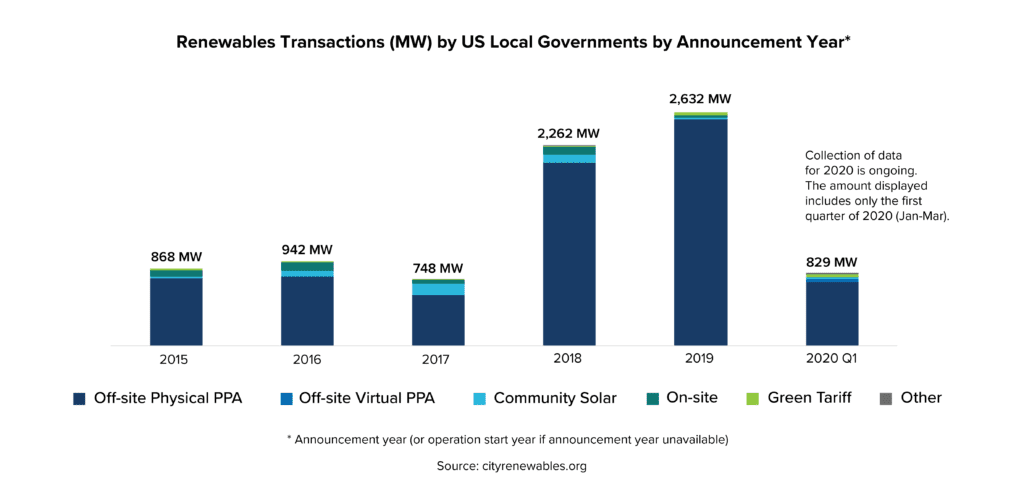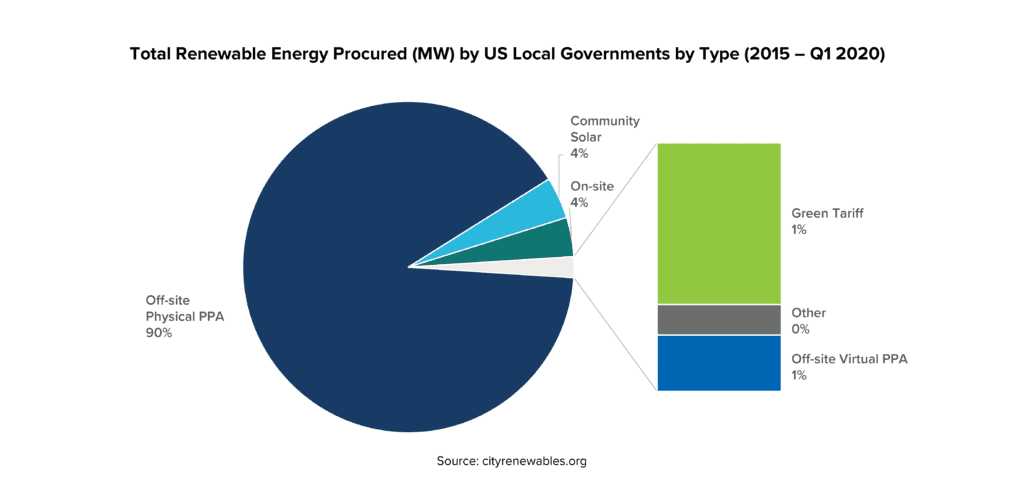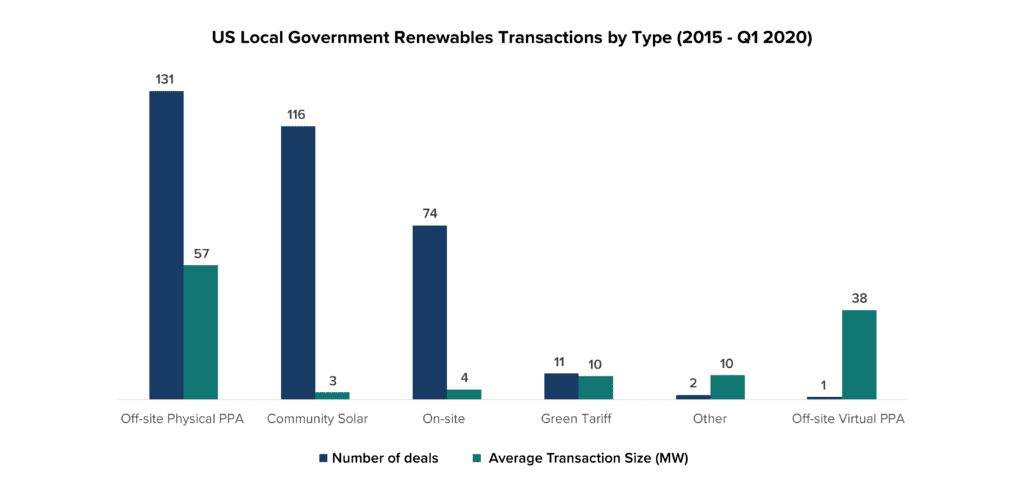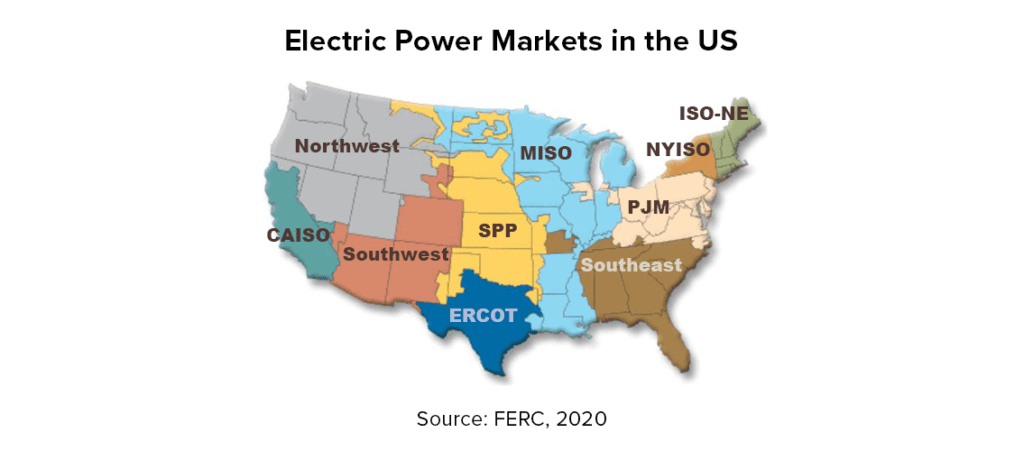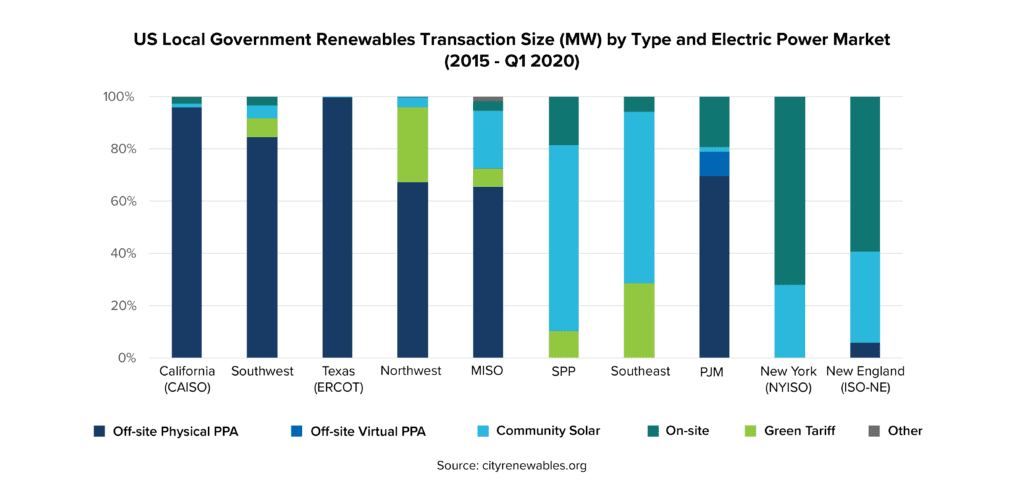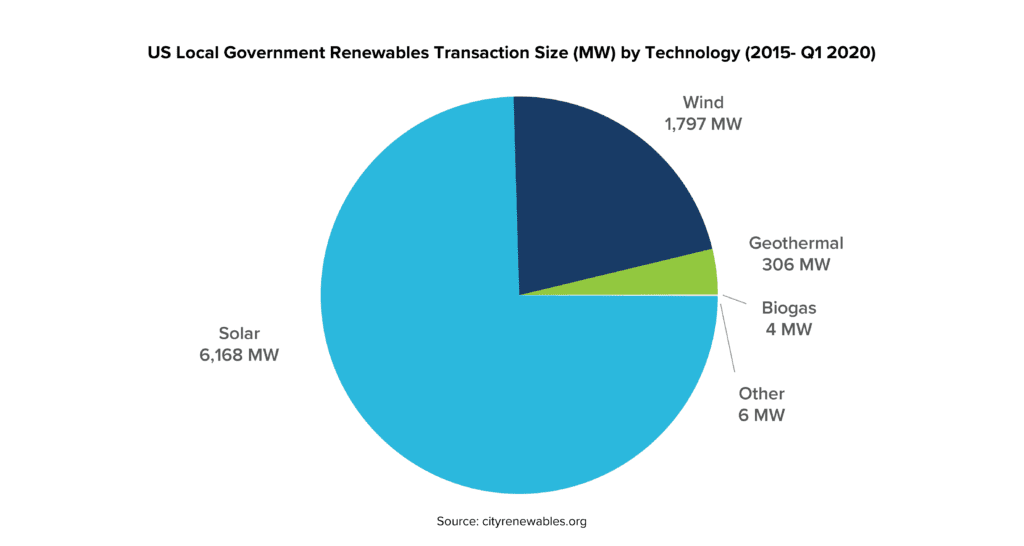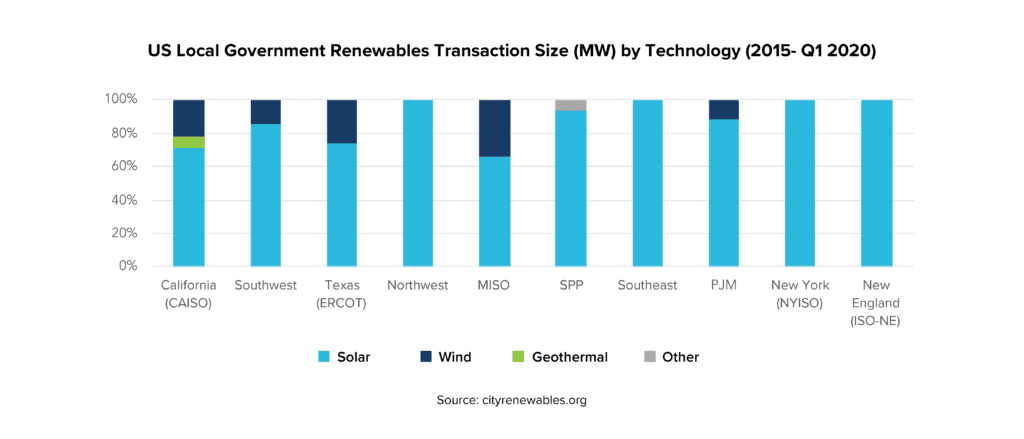Solar panels in the city, photomontage. See my similar pictures:
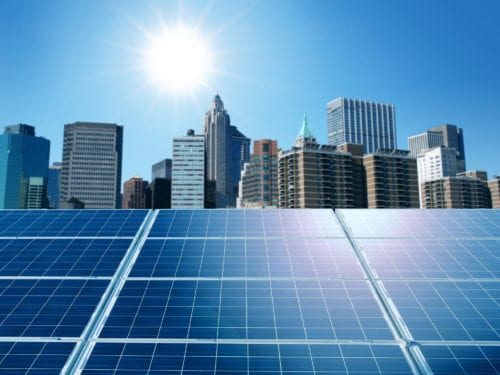
Five Trends: US Cities and Counties Are Going Renewable
Cities are a core driver of climate change, accounting for more than 70 percent of greenhouse gas emissions. Precisely because their communities are such big emitters, local governments can be at the forefront of tackling climate change and leading the switch to clean energy. Over the past five years, more US cities have started setting and acting upon their renewable energy goals. This will be critical for the United States to achieve its Paris Agreement commitments, given the current lack of federal action.
New data shows how cities are making this change by signing deals that move their own municipal operations—and in some cases, their entire communities—away from fossil-fueled electricity and toward renewable energy.
A new tool from the American Cities Climate Challenge Renewables Accelerator, the Local Government Renewables Action Tracker, showcases renewable energy deals made by US cities, counties, tribal governments, municipal utilities, and community choice aggregations since 2015. Cataloguing over 300 deals, the tool equips local governments with the resources to understand what other cities have accomplished, which can help as they develop their own renewable energy strategies and figure out how to effectively collaborate.
The tool reveals the immense impact that cities can have on national clean energy trends, helping to make these efforts more commonplace. Here are five renewable energy trends we’ve seen across US local governments in the past five years:
1. Renewable energy procurement by US local governments is rising dramatically.
Between 2015 and the first quarter of 2020, US cities signed 335 renewable energy deals totaling 8.28 gigawatts (GW)—roughly the same as the collective electric generation capacity in Alaska, Hawaii, Rhode Island, and Vermont. This power, procured through on-site projects, community solar projects, utility green tariffs, and off-site power purchase agreements (but not including unbundled renewable energy certificate purchases), is equivalent to nearly one percent of the total current electric generating capacity installed in the United States.
In 2018 and 2019 respectively, renewable energy purchases made by local governments were over three times those made in 2017. This spike came not long after the federal government’s June 2017 announcement of its intended withdrawal from the Paris Agreement, an event that spurred many subnational governments to commit to formal climate and clean energy goals. Implementation of these goals, combined with the declining costs of renewable electricity, help explain the growing interest in clean energy procurement among city and county governments.
2. Most of the renewable energy capacity purchased by local governments in the past five years occurred in California and Texas, but procurement continues to grow substantially throughout the country.
California and Texas accounted for about 84 percent of the total renewable energy purchased by cities between 2015 and early 2020. The prominent role of these two states is no surprise, given that they are the country’s largest electricity consumers and enjoy easy access to abundant wind and solar resources. Both also allow retail electric choices and have the local autonomy needed to access renewable energy options such as community choice aggregation (CCAs), which allows local governments to aggregate the power demand of their residents and businesses to get more leverage to choose cleaner power sources, which could contribute to their higher rates of procurement.
There is also a lot of progress in other regions, including through community solar projects in Minnesota, Massachusetts, and Washington. Collectively, there were more than 120 clean energy transactions by local governments in the other most active states.
3. Local governments are using off-site power purchase agreements (PPAs) to drive most of their new local renewable energy capacity.
The tracker shows that 90 percent of the renewable energy capacity purchased was completed through off-site PPAs, contracts between a buyer and a developer for renewable energy projects that are not located at the site of the buyer’s electricity usage. Off-site PPAs allow local governments to purchase energy from utility-scale projects, which means that these deals can be very large and cost-effective compared to other procurement options, making them a popular choice for cities, especially in deregulated electricity markets that allow retail electric choices.
Although community solar and on-site projects have a smaller average deal size, these two procurement methods remain popular because they tend to be less expensive, and, for on-site projects in particular, allow local governments to host renewable energy projects on their own city- or county-owned property. For this reason, many cities, including Cincinnati, Los Angeles, and New Orleans, built small-scale on-site or community solar projects as a first step before signing large-scale, off-site PPAs.
4. On-site deals are most popular in the Northeast, whereas off-site PPAs make up most of the purchases in California, Texas, and the Southwest.
In the Northeast, most local government renewable energy deals are on-site projects. Favorable distributed solar policies, such as expanded net metering and policies like New York City’s Municipal Solar Strategy, enable a lot of on-site distributed generation. The modest rate of sunshine in this region has also led to relatively few large-scale renewable project options available for off-site PPAs, compared with the Southwest.
Meanwhile, off-site PPAs are most popular in California and Texas, as well as the Southwest and PJM electric markets, because of their abundant renewable energy resources and relatively large amount of open space, which are convenient for developing off-site solar and wind farms. Moreover, 72 out of the 100 off-site PPA transactions in California were made by local CCAs that enable participants to buy power in bulk by aggregating their demand and signing long-term contracts.
5. Solar leads nationally in terms of the number of deals and overall capacity, while individual wind projects are generally larger and have a strong presence in the West.
Solar accounts for 74 percent of overall capacity and 89 percent of the total deals purchased by local governments. Although the amount of solar energy a city gets varies by its location and weather, solar resources are more uniformly distributed across the United States than wind power, making solar more widely accessible and suitable not only for large projects where adequate space is available, but also for smaller on-site and community-scale projects. Given its daytime availability, on-site solar projects are also particularly well-suited for city and county governments, which have electricity demand that often peaks during business hours.
Wind, on the other hand, is by far the leader when it comes to individual project capacity, averaging about 72 megawatts (MW) per project, more than three times the average project capacity for solar. The lack of access to steady, unobstructed wind in cities typically makes urban areas unsuitable for distributed wind projects.
Although solar energy deals make up the majority of capacity purchased across the country, wind has a strong presence in the Southwest and Midwest, thanks to an abundance of wind resources.
What’s Next for Renewables in US Cities?
In total, over 150 US local governments have done renewable energy deals since 2015, and even more have committed to ambitious renewable energy goals. But to achieve their climate and energy targets, local governments will need to accelerate their large-scale renewable energy procurement by creating comprehensive clean energy plans that combine several types of projects and by partnering with each other and other organizations to buy energy together.
In order to maintain momentum and advance the energy transition, many more local governments will need to enter the US renewable energy market. And there are growing opportunities and pathways for doing so as the efforts of early adopters have provided experiences to learn from, renewable energy prices continue to decline, and more resources and tools, such as those on cityrenewables.org, are becoming increasingly available.
By signing more deals to procure renewable energy for their own municipal operations, cities can be a big contributor to decarbonizing the electricity system and tackling climate change, especially in emissions-heavy markets like the Midwest and the Northeast. But looking beyond that, local governments can and should use their ambition to expand renewable energy to their entire communities, using approaches such as Solarize campaigns and inclusive similar community solar initiatives with an emphasis on low-income and minority neighborhoods.
Representing the majority of the US population and GDP, cities are hubs for rapid learning and experimentation, with the potential to be a force that can reshape electricity use in the United States. To enable a clean energy future across the country, we believe that local governments will play an integral role in growing the renewables market and further accelerating these trends.
About the Renewables Accelerator
Leaders in US clean energy development are beginning to realize how important it is to help cities achieve their renewable energy goals. Last year, Bloomberg Philanthropies announced the American Cities Climate Challenge, a two-year program that provides cities with powerful new resources to help them meet their near-term carbon reduction goals. Together with Bloomberg Philanthropies and the Urban Sustainability Directors Network, World Resources Institute (WRI) and Rocky Mountain Institute (RMI) formed the Renewables Accelerator to provide technical support to US cities as they explore new and innovative strategies for procuring renewable energy to meet these goals.
